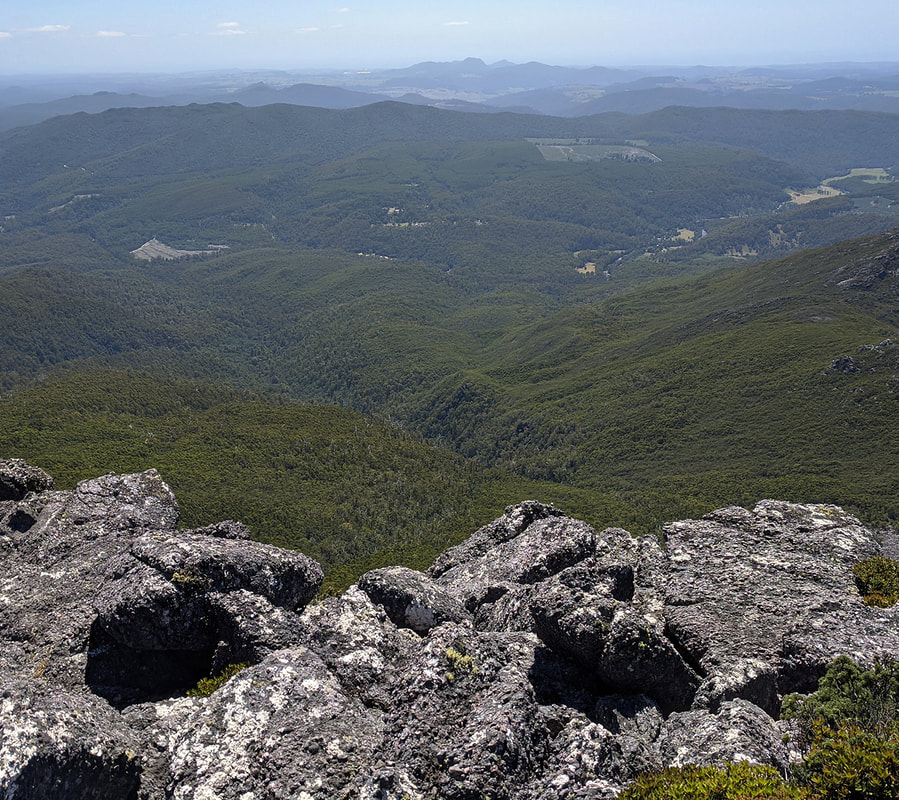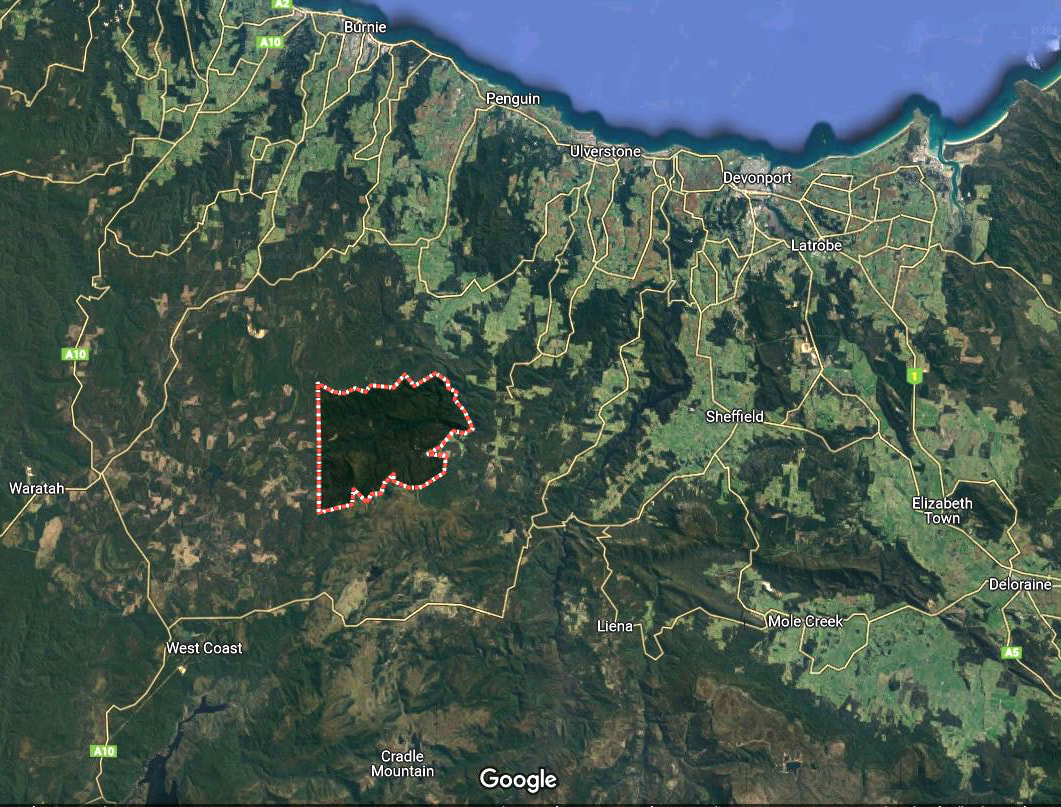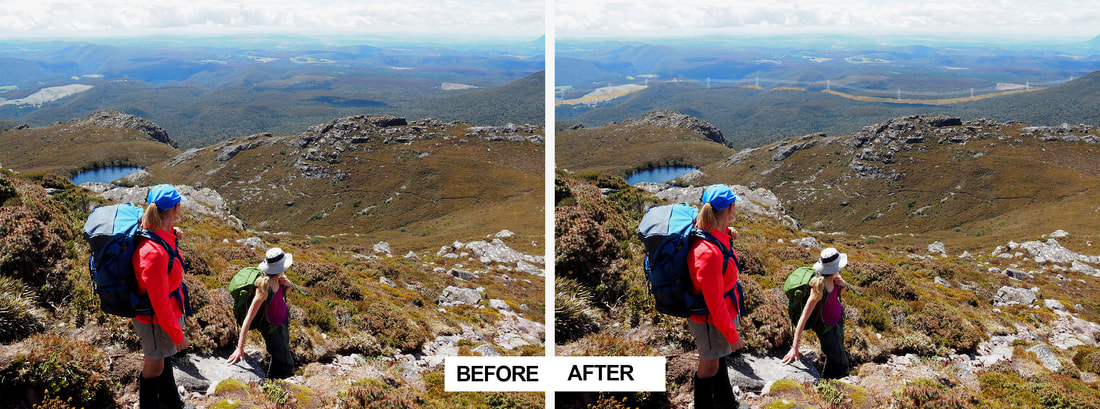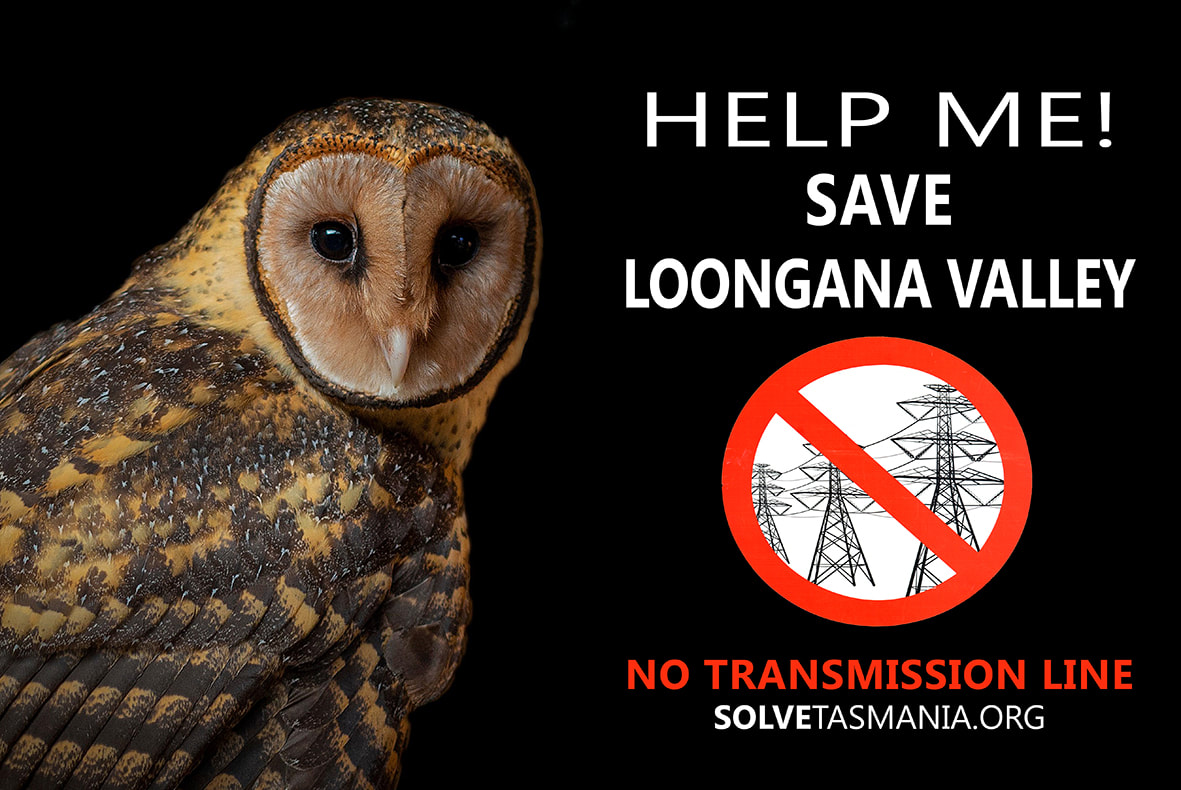Where is Loongana Valley?
Loongana Valley is an hour south of Ulverstone, the most southern locality of the Central Coast Council area, and about 20km north as the eagle flies, from Cradle Mountain. The Valley is nestled between Loongana Range to the north, Black Bluff to the south, the Leven River runs the length with the headwaters up behind the Bluff. Loongana is adjacent to three reserves, providing cruicial wildlife corridors between Leven Canyon Reserve, Winterbrook Falls Reserve and Black Bluff Recreational Area which connects to the Vale of Belvoir and Cradle Mountain beyond. The western side of the Valley is softwood plantations, the Loongana Range is permanent production forest and the northern face of Black Bluff is zoned future production forest. Due to past and current land management Loongana Valley has become a precious greenzone and important biodiversity hotspot.
What is TasNetworks planning to do?
220kv Transmission Line : 60km : 124 towers : 50-90m towers : 60m wide easements : option for a 2nd line
Loongana Valley is in the path of TasNetworks have described as the least contentious route, their preferred route from Staverton to Hampshire. The line is part of the North West Transmission Development and designed to support the contentious Marinus Link undersea cable from Burnie to Victoria.
TasNetworks avoid all mention of Loongana, despite the line directly impacting dozens of residents, covenants and wildlife refuges. Instead, they say the route goes through 'Hampshire Hills', shrug, nothing to see here.
TasNetworks avoid all mention of Loongana, despite the line directly impacting dozens of residents, covenants and wildlife refuges. Instead, they say the route goes through 'Hampshire Hills', shrug, nothing to see here.
Don't we need more transmission lines for renewables? Are you people just nimbys?
It’s true we don’t want transmission infrastructure trashing our iconic tourist views from Cruikshanks’ Lookout, Black Bluff, Paddy’s Lake, Winterbrook Falls and the Penguin-Cradle Trail, and yes, we do need both renewables and transmission.
But both need to be properly sited so they don’t amplify the impacts of our heating climate, or increase biodiversity losses. TasNetworks’ current plans do both to our valley by clearing land, damaging habitats, and harming threatened and endangered species. It’ll also increase the risk of devastating fires. Plus, none of this infrastructure is designed for Tasmanian needs, jobs, or power costs – 90% of any new renewable power will go to the Mainland. It’ll be privately owned, so if we want to use it here to transition our economy, we’ll have to buy it back.
But both need to be properly sited so they don’t amplify the impacts of our heating climate, or increase biodiversity losses. TasNetworks’ current plans do both to our valley by clearing land, damaging habitats, and harming threatened and endangered species. It’ll also increase the risk of devastating fires. Plus, none of this infrastructure is designed for Tasmanian needs, jobs, or power costs – 90% of any new renewable power will go to the Mainland. It’ll be privately owned, so if we want to use it here to transition our economy, we’ll have to buy it back.
Tasmania's covered in forests! Is Loongana Valley really that important?
Considering the issues of ongoing Tasmanian deforestation, the ‘opening up’ of National Parks to privatisation, logging and mining, and the rapid decline of numerous species, including a lengthening list of those officially threatened and endangered, yes – the Loongana Valley, like all of Tassie, is facing a series of tipping points.
It’s no exaggeration to say Loongana Valley is a biodiversity hot-spot, and we’ve engaged with experts to support our citizen science to prove it. This place is amazing! Come visit! Take a walk, sit in a forest, fish the river, watch the birds, marvel at the animals. The more time you spend here, the more you’ll realise just how much is at stake, and how much we can’t afford to lose it.
It’s no exaggeration to say Loongana Valley is a biodiversity hot-spot, and we’ve engaged with experts to support our citizen science to prove it. This place is amazing! Come visit! Take a walk, sit in a forest, fish the river, watch the birds, marvel at the animals. The more time you spend here, the more you’ll realise just how much is at stake, and how much we can’t afford to lose it.
It'll be sad about a few more eagle deaths, but action on climate is the priority, right?
Sadly, it won’t just be more dead eagles; it’ll be multiple species, each one of which interact with and depend on the others. It’s a system – an ecosystem – and if you damage enough parts, continuously, the entire thing crashes and kills everything in it. It is now globally accepted that action on climate also means action on biodiversity, do both or do nothing. TasNetworks high voltage transmission line through Loongana Valley, is the opposite of action on climate.
This is the wrong place for an overhead transmission line.
This is the wrong place for an overhead transmission line.
Okay, so if this is the wrong place to put a line, where should it go?
We don’t know - we’re not energy sector planners. We don’t want to dump our problem on anyone else – we just want any infrastructure we pay for to be planned well, and to benefit Tasmania as a whole. Marinus and the NWTD don’t benefit us, or the State. They cost us and trash our wild forests.
What we do know is that HVDC undergrounding of transmission lines solves a whole bunch of problems about the ‘where’.
Undergrounding tech is safer and more efficient, and only slightly more expensive over the long term. We know they’re doing it routinely overseas despite the up-front costs, and they can run it on existing or narrower easements. Energy sector experts agree that you reduce grid resilience running overhead transmission through forests, and increase fire risks – so let’s stop TasNetworks doing that.
What we do know is that HVDC undergrounding of transmission lines solves a whole bunch of problems about the ‘where’.
Undergrounding tech is safer and more efficient, and only slightly more expensive over the long term. We know they’re doing it routinely overseas despite the up-front costs, and they can run it on existing or narrower easements. Energy sector experts agree that you reduce grid resilience running overhead transmission through forests, and increase fire risks – so let’s stop TasNetworks doing that.
Hang on, don't TasNetworks say undergrounding is 'economically unviable' here?
Call us cynics (and after four years putting up with TasNet’s PR consultants we’re super-cynics), but neither TasNetworks or renewables proponents are considering undergrounding because, basically, they want us to pay for a new grid they benefit from - quickly.
TasNetworks want the new grid – or the promise of a new grid - to attract investors and hopefully provide bigger dividends to the State government. In other words, the priority is serving business interests by burdening us with long-term debt to be paid primarily via taxes and power bills. And if power and profits go offshore, where are the much-promised “jobs and growth” going to be?
Undergrounding is less profitable in the short term, but it avoids all the costs that overhead lines impose on communities and the environment. Overhead lines are environmentally unviable.
TasNetworks want the new grid – or the promise of a new grid - to attract investors and hopefully provide bigger dividends to the State government. In other words, the priority is serving business interests by burdening us with long-term debt to be paid primarily via taxes and power bills. And if power and profits go offshore, where are the much-promised “jobs and growth” going to be?
Undergrounding is less profitable in the short term, but it avoids all the costs that overhead lines impose on communities and the environment. Overhead lines are environmentally unviable.
Tasmania's already clean and green 100% renewable, so why not help the Mainland?
While Tasmania has a historical advantage with hydro energy, our government is still subsidising fossil fuel exploration and extraction. Our rate of native forest logging isn’t sustainable, nor is our use of coastal areas for industrialised fish farming. Our rivers are being over-extracted, and that industrial and agricultural use is set to soar – all this while our climate is rapidly drying and warming. Meanwhile, we’re often buying power from the Mainland, most of which is still coal-fired power.
Like every State and country, Tasmania needs to do more within its own borders. If we’re shipping new renewable energy for private sale on the NEM, we’re not planning the use of that energy to transition our own economy. Perhaps we’ll be able to afford to buy it back, perhaps we won’t – right now we’re giving away wind energy and selling, often for a guaranteed price to private investors, that same energy, often at a loss to ourselves. We’re socialising costs, privatising profits. Resting on laurels with hydro power, and telling international investors to set up wind farms pretty much wherever they like, isn’t acting on climate; it’s speculating on a market we don’t control. And bulldozing forests in Loongana Valley to help investors is anything but ‘clean and green’. Read more analysis of Project Marinus here.
Like every State and country, Tasmania needs to do more within its own borders. If we’re shipping new renewable energy for private sale on the NEM, we’re not planning the use of that energy to transition our own economy. Perhaps we’ll be able to afford to buy it back, perhaps we won’t – right now we’re giving away wind energy and selling, often for a guaranteed price to private investors, that same energy, often at a loss to ourselves. We’re socialising costs, privatising profits. Resting on laurels with hydro power, and telling international investors to set up wind farms pretty much wherever they like, isn’t acting on climate; it’s speculating on a market we don’t control. And bulldozing forests in Loongana Valley to help investors is anything but ‘clean and green’. Read more analysis of Project Marinus here.
After a few years, won't you forget the lines are even there?
In short, no. We are talking about inter-generational harm here. We’ll be aware of less wildlife, more dead wildlife, corona noise on still nights, run-off polluting water catchment, and increased worry during fire season and dry lightning storms. We’ll watch the forests either side of the lines dry out, and see previously protected rainforest be exposed directly to the high winds we have here – the forest will thin and warm up and begin to preference gums. We’ll notice more weeds brought in by construction and maintenance crews as they find fertile new bare ground to infest. We’ll notice more feral cats utilising the now open hunting grounds under the lines. We’ll notice watercourses blocked or diverted. We’ll notice cave fauna impacted, and creatures like the endangered Giant Freshwater Crayfish, sensitive to polluted water, struggle. We’ll notice our valley change in entirety, as the entire system is pushed over a series of ecological tipping points. It’ll be heartbreaking and ongoing, and it will get worse as time goes by.
Are TasNetworks right when they say their easements will make good fire breaks?
Nope. Firebreaks are specially designed features taking into account terrain and wind direction. While it’s true that new service tracks and easements can potentially allow fire services to access areas inside forests, being near or under high voltage lines in thick smoke and high temperatures is regarded by experts as unsafe. Mainland brigades are protesting, saying that transmission lines in forests are unsafe for communities, and that they will refuse attend fires under or near any new lines.
Are Marinus and the North West Transmission Development (NWTD) separate?
Yeah but nah. They’re two halves of the proposed upgraded and expanded grid, intended to cater for increased renewable energy production, and to supply that energy to the National Energy Market (NEM).
The NWTD is intended to link energy from new windfarms to the NEM via Basslink and Marinus, but Marinus 1 is just the first part of TasNetworks’ plan for at least four Marinus undersea cables to the Mainland.
The NWTD is intended to link energy from new windfarms to the NEM via Basslink and Marinus, but Marinus 1 is just the first part of TasNetworks’ plan for at least four Marinus undersea cables to the Mainland.
Isn't it good the Tasmanian government gets money from new windfarms leasing the lines?
Yes and no. Because TasNet and the government are saddling us with the debt for the new transmission infrastructure, any TasNet and TasHydro dividends will go into General Revenue rather than paying us back for higher power prices. If we’re lucky, that money will support better services, but the independent energy sector analysis shows we’ll lose money overall. Just as our State government and energy sector authorities made decisions that saw Basslink produce huge losses and debts for Tasmanian taxpayers, Marinus and the NWTD offer no confidence that TasNet’s market gamble will pay off.
What a bunch of whingers! Fine! So what would you do instead?
We’d halt Project Marinus, encourage more input from community and independent energy sector analysts, and begin new planning. At the moment, the series of ad hoc decisions by TasNet and the government add up to a bad and risky plan. We should keep any good bits, prioritise the needs of the Tasmanian people, and act on climate by protecting our wild forests and endangered flora and fauna.
If we own the transmission, perhaps we should also own and build affordable renewable power at the rate we need it, not subsidise foreign renewables companies to cover our north in windfarms to supply the cheap energy Market investors demand.
If we own the transmission, perhaps we should also own and build affordable renewable power at the rate we need it, not subsidise foreign renewables companies to cover our north in windfarms to supply the cheap energy Market investors demand.
Questions? Contact us!
|














